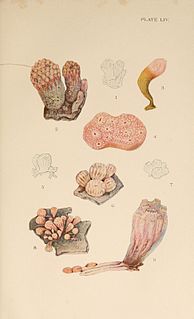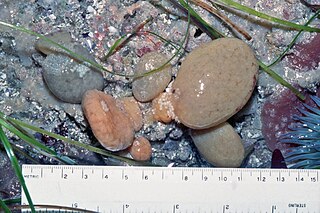
A tunicate is a marine invertebrate animal, a member of the subphylum Tunicata. It is part of the Chordata, a phylum which includes all animals with dorsal nerve cords and notochords. The subphylum was at one time called Urochordata, and the term urochordates is still sometimes used for these animals. They are the only chordates that have lost their myomeric segmentation, with the possible exception of the seriation of the gill slits.

The Thaliacea comprise a class of marine animals within the subphylum Tunicata. Unlike their benthic relatives the ascidians, thaliaceans are free-floating (pelagic) for their entire lifespan. The group includes species with complex life cycles with both solitary and colonial forms.

Ascidiacea is a paraphyletic class in the subphylum Tunicata of sac-like marine invertebrate filter feeders. Ascidians are characterized by a tough outer "tunic" made of the polysaccharide cellulose.

Botryllus schlosseri is a colonial ascidian tunicate. It is commonly known as the star tunicate, but it also has several other common names, including star ascidian and golden star tunicate. Colonies grow on slow-moving, submerged objects, plants, and animals in nearshore saltwater environments.

Botrylloides violaceus is a colonial ascidian. It is commonly known as the chain tunicate, but has also been called several other common names, including: lined colonial tunicate, orange sheath tunicate, orange tunicate, and violet tunicate. Its native range is in the northwest Pacific from southern China to Japan and Siberia. Colonies grow on solid substrates and consist of individuals arranged in twisting rows. Outside its native range, it is considered an invasive species and is becoming more common in coastal waters of North America and other waters around the world, likely being spread by shipping industries.

Aplidium californicum is a species of colonial sea squirt, a tunicate in the family Polyclinidae. It is commonly known as sea pork.
Aplidium solidum is a species of colonial sea squirts, a tunicate in the family Polyclinidae. It is commonly known as the red ascidian or sea pork.
Ecteinascidia turbinata, the mangrove tunicate, is a sea squirt species in the genus Ecteinascidia, which was described to science in 1880 by William Abbott Herdman. The cancer drug trabectedin is isolated from E. turbinata.

Didemnum molle is a species of colonial tunicate in the family Didemnidae. It is commonly known as the tall urn ascidian, the green barrel sea squirt or the green reef sea-squirt. It is native to the Red Sea and the tropical waters of the Indo-Pacific region.

Didemnum vexillum is a species of colonial tunicate in the family Didemnidae. It is commonly called sea vomit, marine vomit, pancake batter tunicate, or carpet sea squirt. It is thought to be native to Japan, but it has been reported as an invasive species in a number of places in Europe, North America and New Zealand. It is sometimes given the nickname "D. vex" because of the vexing way in which it dominates marine ecosystems when introduced into new locations, however the species epithet vexillum actually derives from the Latin word for flag, and the species was so named because of the way colonies' long tendrils appear to wave in the water like a flag.
Amathia vidovici is a species of colonial bryozoans with a tree-like structure. It is found in shallow waters over a wide geographical range, being found in both the Atlantic and Pacific Oceans and adjoining seas.
Molgula occulta is a species of solitary tunicate in the family Molgulidae. It is native to the north eastern Atlantic Ocean, the North Sea and the Mediterranean Sea. The specific name occulta means "tailless" and refers to the tunicate's larva, which lacks the tail found in some other species in the genus Molgula.

Diazona violacea is a species of tunicate, an ascidian in the family Diazonidae. It is the type species of the genus Diazona.
Molgula citrina is a species of solitary tunicate in the family Molgulidae. It is found on both sides of the northern Atlantic Ocean and in the Arctic Ocean. In 2008 it was found in Kachemak Bay in Alaska, the first time it had been detected in the Pacific Ocean.

Morchellium argus, the red-flake ascidian, is a species of colonial sea squirt, a tunicate in the family Polyclinidae. It is native to shallow water in the northeastern Atlantic Ocean, especially round the coasts of Britain.

Polyclinum aurantium is a species of colonial sea squirt, a tunicate in the family Polyclinidae. It is native to shallow water in the northeastern Atlantic Ocean and Mediterranean Sea.

Polyclinum planum, is a compound ascidian commonly known as the Elephant Ear Tunicate. It is an ascidian tunicate in the family Polyclinidae. Ascidians are also known as sea squirts.

Phallusia mammillata is a solitary marine tunicate of the ascidian class found in the eastern Atlantic Ocean and the Mediterranean Sea.
Pyura haustor is a species of sessile ascidian, or sea squirt, that lives in coastal waters in the northeastern Pacific Ocean, attached to rocks or artificial structures. Common names for this species include the wrinkled seapump, the wrinkled sea squirt and the warty tunicate.
Aspidosiphon elegans is a species of unsegmented benthic marine worm in the phylum Sipuncula, the peanut worms. It is a bioeroding species and burrows into limestone rocks, stones and corals. It occurs in the western Indo-Pacific region, the Red Sea, and the tropical western Atlantic Ocean, and is invasive in the eastern Mediterranean Sea.













